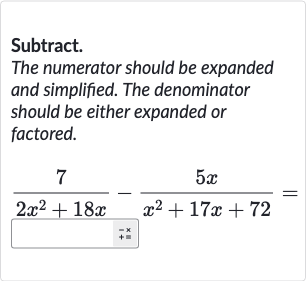Full solution
Q. Subtract.The numerator should be expanded and simplified. The denominator should be either expanded or factored.
- Identify common denominator: Identify the common denominator for the two fractions.The denominators are and . To combine the fractions, we need a common denominator. The common denominator will be the least common multiple (LCM) of the two denominators.
- Factor denominators: Factor the denominators if possible.The first denominator, , can be factored by taking out the common factor of , which gives us .The second denominator, , can be factored into .
- Determine LCM of factored denominators: Determine the LCM of the two factored denominators.The LCM of and is , since is common in both and we need to include all other distinct factors.
- Rewrite fractions with common denominator: Rewrite each fraction with the common denominator.The first fraction becomes and the second fraction becomes . To have the same denominator, we multiply the numerator and denominator of the first fraction by and the numerator and denominator of the second fraction by .
- Multiply numerators by appropriate factors: Multiply the numerators by the appropriate factors.For the first fraction, we have .For the second fraction, we have .
- Expand numerators: Expand the numerators.For the first fraction, we have .For the second fraction, we have .
- Subtract second fraction from first fraction: Subtract the second fraction from the first fraction.Now we have .
- Combine numerators: Combine the numerators.We get .
- Simplify numerator: Simplify the numerator.We have .
- Check for possible simplification or factoring: Check for any possible simplification or factoring. The numerator is a quadratic expression and does not factor further in relation to the denominator. Therefore, this is the final simplified form of the expression.
More problems from Negative Exponents
QuestionGet tutor help

